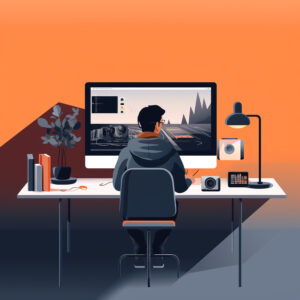10 Essential Remote Working Hacks for Staying Focused
Mastering the Art of Remote Productivity
Remote working can offer incredible flexibility and freedom, but it also comes with its own set of challenges. Staying focused while working from home is one of the biggest hurdles many face. By implementing some practical hacks, you can enhance your productivity and maintain a high level of concentration.
We strongly recommend that you check out our guide on how to take advantage of AI in today’s passive income economy.
Table of Contents
Creating an Ideal Work Environment
Your workspace plays a crucial role in how focused you can remain. To ensure you have the right setting for remote working, start by selecting a quiet, comfortable area. Ideally, this space should be dedicated solely to work to help create a mental separation between professional and personal life.
Ensure your workspace is ergonomically friendly. Invest in a good chair and desk that support good posture. A well-organized workspace can significantly reduce distractions and make it easier to stay focused. Keep your desk tidy, with only the essential items within reach.
Natural light can boost your mood and energy levels. Position your desk near a window if possible, or use bright, cool lighting to mimic daylight. A pleasant and well-lit environment can make remote working more enjoyable and help you stay alert.
Establishing a Routine and Setting Boundaries
One of the most effective remote working hacks is to establish a daily routine. A consistent schedule helps signal to your brain when it’s time to work and when it’s time to relax. Start your day at the same time and follow a routine that mimics a traditional office environment.
Define clear boundaries between work and home life. Inform family members or housemates of your work hours to minimize interruptions. Use physical cues, such as closing your office door or setting a “do not disturb” sign, to reinforce these boundaries.
Incorporate breaks into your routine. Short breaks throughout the day can help you stay focused and prevent burnout. Consider using techniques like the Pomodoro Technique, where you work for 25 minutes and then take a 5-minute break.
Utilizing Productivity Tools and Technology
Leverage productivity tools to streamline your remote working experience. Tools like task management apps and calendar software can help you keep track of deadlines and manage your workload. Use project management tools like Asana or Trello to organize tasks and collaborate with your team.
Time-tracking apps can also be beneficial. They help you understand how much time you spend on different tasks and identify areas where you can improve efficiency. Popular time-tracking tools include Toggl and Clockify.
Consider using noise-canceling headphones if you work in a noisy environment. These can help you concentrate by blocking out distracting sounds. Pair them with productivity playlists or white noise for added focus.
Staying Connected and Maintaining Communication
Effective communication is essential for remote working success. Make an effort to stay connected with your team through regular check-ins and virtual meetings. Use video conferencing tools like Zoom or Microsoft Teams to facilitate face-to-face interactions.
Keep communication channels open with your colleagues. Use instant messaging apps like Slack or Microsoft Teams to discuss quick questions and collaborate in real time. Regular communication helps prevent misunderstandings and keeps everyone aligned.
Set clear expectations for availability and response times. Let your team know when you are available and when you will respond to messages. This helps manage expectations and ensures smooth collaboration.
Managing Distractions and Maintaining Focus
Distractions can be a significant barrier to productivity when remote working. To manage distractions, create a list of tasks to focus on each day. Prioritize your tasks and tackle the most important ones first.
Minimize interruptions by setting up a do-not-disturb zone. Use apps that block distracting websites and notifications during work hours. Tools like Freedom or StayFocusd can help you stay on track by limiting your access to non-essential sites.
Consider creating a work playlist to enhance concentration. Music or ambient sounds can improve focus for some people. Experiment with different types of music or sounds to see what works best for you.
Balancing Work and Personal Life
Balancing work and personal life is crucial for maintaining overall well-being while remote working. Set specific work hours and stick to them. Avoid working late into the evening or on weekends to ensure you have time to relax and recharge.
Engage in regular physical activity to boost your energy levels and reduce stress. Incorporate exercise into your daily routine, whether it’s a morning jog, a quick workout session, or yoga. Physical activity can improve focus and overall mental health.
Make time for social interactions outside of work. Schedule virtual coffee breaks with friends or family to stay connected and combat feelings of isolation. Social interaction can provide a much-needed break from work and enhance your mood.
Staying Motivated and Setting Goals
Staying motivated can be challenging when working remotely. Set clear, achievable goals for each day to maintain a sense of purpose and direction. Break larger projects into smaller tasks to make them more manageable and less overwhelming.
Reward yourself for completing tasks. Use a reward system to motivate yourself to finish tasks and stay on track. Whether it’s a treat, a break, or something else you enjoy, rewards can provide positive reinforcement and keep you motivated.
Reflect on your progress regularly. Take time to assess what you’ve accomplished and identify areas for improvement. Regular reflection helps you stay aware of your goals and adjust your strategies as needed.
Optimizing Your Remote Working Space
Optimizing your remote working space involves more than just physical arrangement. Consider the technology you use and ensure it meets your needs. Upgrade your internet connection if necessary to avoid disruptions during virtual meetings.
Personalize your workspace to make it more comfortable and inspiring. Add elements that motivate you, such as plants, artwork, or personal photos. A well-designed space can make remote working more enjoyable and boost your productivity.
Evaluate your workspace regularly. Make adjustments as needed to ensure it continues to meet your needs and support your productivity. Small changes, such as rearranging furniture or adding new tools, can have a significant impact on your remote working experience.
Embracing Flexibility and Adaptability
One of the key benefits of remote working is flexibility. Embrace this flexibility by adjusting your work schedule to match your peak productivity times. If you’re more focused in the morning, schedule your most challenging tasks during that time.
Be open to adapting your strategies as needed. Remote working may require ongoing adjustments to find what works best for you. Experiment with different techniques and tools to discover the most effective ways to stay focused and productive.
Accept that remote working is a continuous learning process. Stay updated with new tools and techniques that can enhance your productivity. Embracing change and innovation can help you stay ahead and maintain a high level of focus.
Conclusion
Remote working presents unique opportunities and challenges. By implementing these essential hacks, you can enhance your focus and productivity. Create an ideal workspace, establish a routine, utilize productivity tools, stay connected, manage distractions, balance work and personal life, and stay motivated.
Adapting to remote working requires patience and perseverance. With the right strategies and mindset, you can overcome the challenges and make the most of the flexibility remote work offers. Remember, the key to successful remote working is finding what works best for you and continuously refining your approach.
By incorporating these tips into your remote working routine, you’ll be well on your way to achieving a productive and fulfilling work-from-home experience.
FAQs:
What is the meaning of remote working?
Remote working refers to a work arrangement where employees perform their job duties from a location other than the traditional office environment. This can include working from home, a co-working space, or any other place with an internet connection. The primary advantage of remote working is the flexibility it offers, allowing employees to balance their work and personal lives more effectively. This setup typically involves using digital tools and technology to communicate and collaborate with team members and complete tasks efficiently.
What is the remote working method?
The remote working method is a flexible approach to work where employees carry out their responsibilities outside of a conventional office. This method relies on digital communication tools, project management software, and cloud-based platforms to facilitate collaboration and productivity. Remote working methods often include setting up a home office, adhering to flexible working hours, and maintaining regular virtual meetings to stay connected with colleagues and managers. It emphasizes trust and self-management, allowing employees to work independently while achieving their goals and meeting deadlines.
How do you explain remote work?
Remote work is a modern work arrangement that allows employees to work from locations other than a centralized office. This setup is facilitated by digital technologies such as email, video conferencing, and collaboration tools that enable employees to perform their tasks and communicate with their teams from virtually anywhere. Remote work can vary in terms of frequency, from full-time remote positions to hybrid models where employees split their time between home and the office. The goal of remote work is to provide greater flexibility and work-life balance while maintaining productivity and collaboration.
What is the work of remote?
The work of remote, or remote work, involves carrying out job responsibilities from a location other than the traditional office. This includes tasks such as managing projects, attending virtual meetings, communicating with team members, and completing assignments using digital tools and platforms. Remote work requires employees to be self-motivated and disciplined, as they must manage their time effectively and stay organized without direct supervision. The nature of remote work can vary depending on the industry and role but generally involves leveraging technology to ensure that work is completed efficiently and effectively from any location.

We strongly recommend that you check out our guide on how to take advantage of AI in today’s passive income economy.




